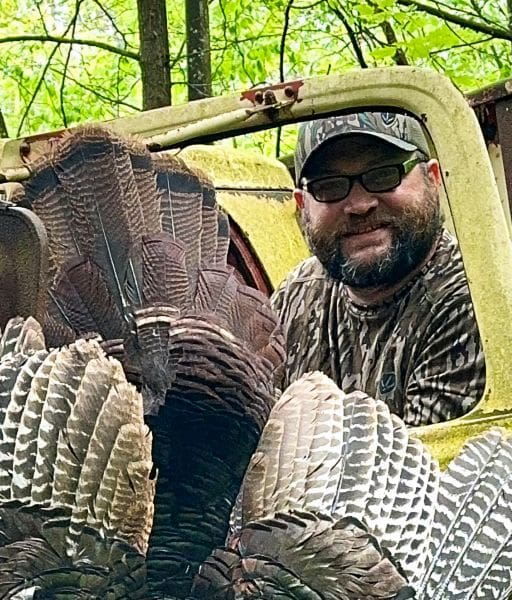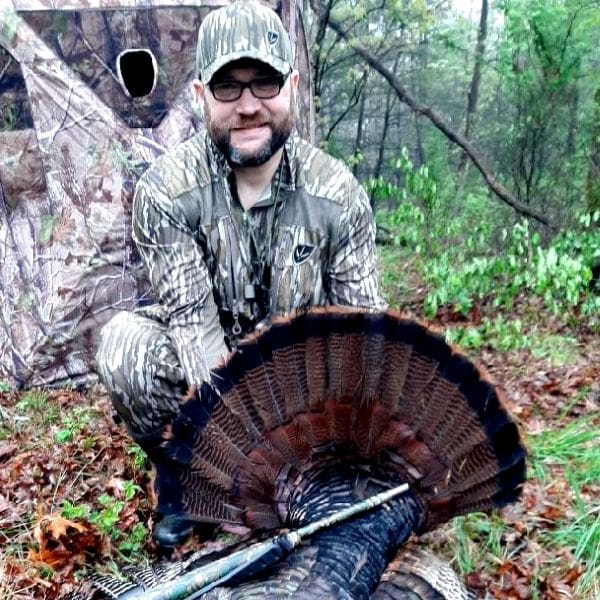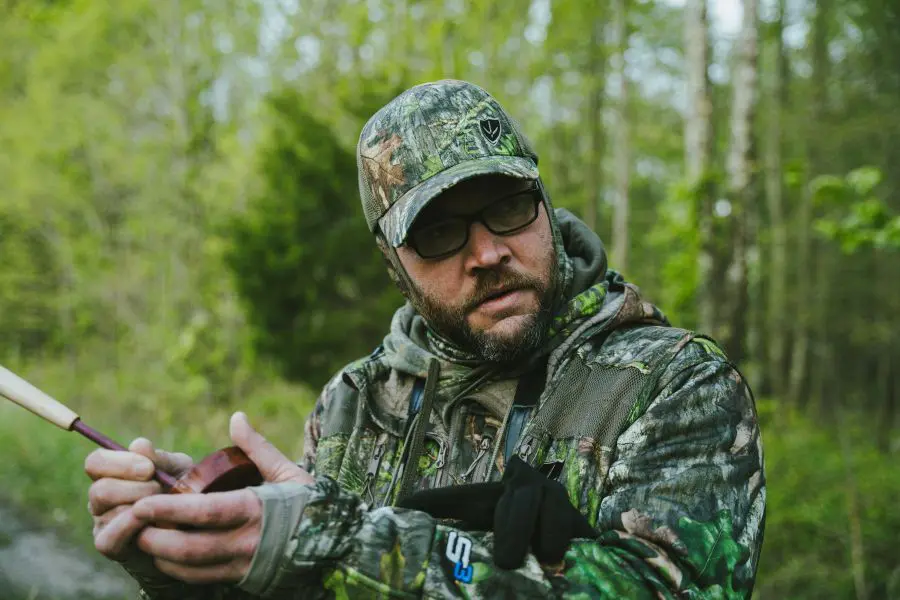Turkey calling isn’t just about making noise; it’s a language. And like any language, tone, timing, and context matter. While many hunters take a subtle, soft-spoken approach to calling, there’s a time and place for dialing it up. When used with purpose, aggressive calling can be one of the deadliest tactics in the turkey woods, especially when dealing with call-shy, pressured gobblers. Blocker Outdoors pro and contest caller Jason Powell likes to ramp up his calling and maintain his aggressive style to help bring in longbeards for several years.
But what does “aggressive” really mean when it comes to calling?

Aggressive vs. Subtle Calling
Subtle calling may consist of soft clucks, purrs, and the occasional yelp. Think of it as a conversational whisper meant to reassure a wary tom. Aggressive calling, on the other hand, is a bold and demanding approach. Powell explains aggressive calling is typically made up of cutting and excited yelping, and a lot of it. “Fast, sharp cutts, loud yelping, rapid sequences, and even gobbler calls. It’s not about finesse, it’s about creating urgency, dominance, and often, chaos in the turkey’s world.” He added that enhancing his calling can also be creative, such as using kee kees and whistles like those of young turkeys or a lost turkey. Powell says he has used kee kees, which are often used in the fall, for a more aggressive approach in the spring. Using these types of calls has made hens that were holding the gobbler’s attention break away and go searching for the source of the sound, which in turn makes the gobbler follow close behind.
Aggressive calling is like picking a fight in the turkey woods. A veteran hunter once explained. “You’re trying to convince that gobbler that he’s missing the party, and if he doesn’t come now, he’s gonna lose his hen to another tom.”
Why It Works – Especially on Pressured Birds
While pressured birds are notorious for hanging up or going quiet, aggressive calling can sometimes short-circuit their hesitation. It disrupts their usual script.
“If a bird has heard every soft yelp in the book from every hunter in the county, sometimes the only way to break through is by being different—louder, more intense, and more convincing,” another seasoned hunter shared. “You’re tapping into their jealousy, curiosity, or territorial aggression.”
Best Times in the Season to Go Aggressive
Is there a good or bad time to call aggressively? Early season can often be a prime time for aggressive calling when toms are still sorting out the pecking order. During this time, dominance is front and center, and loud, combative calling can challenge a gobbler in the right way. Later in the season, when gobblers are henned up or less vocal, aggressive tactics can simulate a rival tom stealing hens, pulling birds away out of frustration or instinct. Powell explains that aggressive calls can work anytime in the right situation. “Realistically, aggressive calling can work throughout the entire season; it could work in July if a turkey is aggressively responding; you can be as aggressive as he will let you be.” He then added that you’re going to bump turkeys, saying he has bumped as many as he has killed because his tactics are more aggressive. Powell goes on to say that the earlier in the season, the more action will happen. “I don’t know if it is because I get tired, or the toms get worn out, but later in the season, typically you see less aggressive vocabulary from turkeys, both hens and gobblers.”
One of the best ways to determine when to ramp up your calling comes from reading a gobbler’s mood, or, as I have even heard it referred to, their body temperature. “If a tom is cutting me off as soon as I make a call, I know he is hot, ready, and interested, and I then get aggressive to get him where I want him to be,” says Powell. He added that if you have a super excited gobbler, you can manipulate him to go where he wants. If a tom is strutting and gobbling, he is not moving. This is when Powell says you need to let him breathe and maybe not call as much. Call more often when he moves towards you again and keep him fired up. Reading a tom’s body language is vital.

Don’t Be Afraid To Over-Call
Many turkey hunters avoid a more aggressive approach to calling because they fear that they will call too much. If the tom is coming, let him come. Veteran turkey hunters often say to stay quiet, let the tom get curious, and look for you. Yet, Powell says that is not always true, and hunters should not be afraid to fail. “If you are afraid you’re going to screw up, you’re never going to learn.” Most of the popular or renowned hunters are not afraid to try everything. Powell states that you will mess up on turkeys; it happens. The interaction between you and the turkey keeps hunters returning for more. Powell goes on to say that some hunters forget about the interaction and simply kill one and move on to the next one. He explains that, in recent years, he has had a passion for taking photos of turkeys, just as much as he does for shooting them with a gun. All this passion and love of turkey hunting for Powell comes from the interaction of calling more and having turkeys respond back and forth to his calling. “You never know if it is going to work unless you try it, be like the old Nike slogan, and just do it,” says Powell.
On a recent hunt, Powell’s aggressive techniques paid off. A group of hens was across a field, accompanied by one tom. Powell recalls that he was in a wood line, where he watched the tom strut back and forth for over an hour. He first set up on this tom at 8:30 a.m. and did not get him killed until 11:30 a.m. Powell explains that he would get aggressive, prompting the tom to start coming toward him, yet he would stop just out of range each time. Finally, after hours of calling, he began a sequence of kee kees and a lost call directed towards the hens that kept the tom from coming the rest of the way into range each time. “It was one of the most incredible hunts I have had in years,” says Powell. He adds that four hens came up within ten feet of him after he did the aggressive kee kees, which led the tom to the same distance, where Powell finally got the shot at ten steps. “That was a long time to set in a ready position while waiting on a turkey; I was getting frustrated and was trying to learn more while looking through my shotgun scope at these turkeys.” He added that when he whistled the first time, all the hens’ heads came up, which is when he read their language enough to start aggressively calling with whistles and kee kee’s until they finally couldn’t take it anymore.

Mastering aggressive turkey calling is about much more than simply being loud, it’s about reading each bird’s mood, responding purposefully, and not being afraid to take chances. As Jason Powell emphasizes, aggressive tactics like rapid cutting, excited yelping, and even creative calls like kee kees can break through the hesitation of pressured or henned-up gobblers. While not every aggressive approach will end in success, each interaction offers valuable lessons, building the skills that make turkey hunting so addictive. By trusting your instincts, adapting to the turkey’s behavior, and embracing a bold calling style, hunters can unlock exciting encounters and, ultimately, more success in the spring woods.



